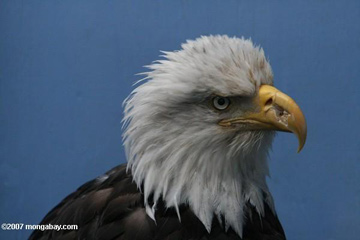25% of American birds threatened
25% of American birds threatened
mongabay.com
November 29, 2007
More than one quarter of the bird species found in the United States are imperiled, reports a new survey by the National Audubon Society and the American Bird Conservancy. Overall 178 species in the continental U.S. and 39 in Hawaii are listed on WatchList 2007, which is based on a comprehensive analysis of population size and trends, distribution, and threats for 700 bird species in the U.S.
“We call this a ‘WatchList’ but it is really a call to action, because the alternative is to watch these species slip ever closer to oblivion,” said co-author Greg Butcher, Audubon Bird Conservation Director. “Agreeing on which species are at the greatest risk is the first step in building the public policies, funding support, innovative conservation initiatives and public commitment needed to save them.”
 The bald eagle, which has dramatically recovered and is no longer considered an endangered species, is not listed. |
The list identifies 59 continental and 39 Hawaiian “red list” species of greatest concern, and 119 more in the “yellow” category of seriously declining or rare species.
“Adoption of this list as the ‘industry standard’ will help to ensure that conservation resources are allocated to the most important conservation needs,” said co-author David Pashley, American Bird Conservancy’s Director of Conservation Programs. “How quickly and effectively we act to protect and support the species on this list will determine their future; where we’ve taken aggressive action, we’ve seen improvement.”
Despite ongoing challenges and their continued place on the list, the status of some WatchList species is improving. Several species have benefited from federal protection under the Endangered Species Act (ESA).
“Habitat loss due to development, energy exploration and extraction, and the impact of global warming remain serious threats for the most imperiled species, along with others on both the red and yellow lists,” said Pashley. “Concerted action will be needed to address these threats.”
“Everyone, from conservation groups to policy-makers and birdwatchers, needs to take a hard look at these lists and use them to inform and hone our conservation approaches and funding priorities while there’s still time,” added Butcher. “It’s astounding that several are so close to the edge but haven’t even received Endangered Species Act protection-this list is a reminder that we need to act and act now.”
WatchList 2007
Related articles
 |
U.S. bird populations plummet
(6/14/2007) Populations of some of America’s most common birds have plummeted over the past forty years, reports a new analysis by the National Audubon Society. Some species have seen a decline of 80 percent. The study, which combines the National Audubon Society’s Christmas Bird Count with summertime surveys by the U.S. Geological Survey, found California species were particularly affected, with populations declines of 75 to 96 percent for several species, including the Northern Pintail, Horned Lark, and Loggerhead Shrike.
 |
10-20% of birds extinct by 2100 due to global warming, deforestation
(6/4/2007) Ten to twenty percent of the world’s terrestrial bird species could be threatened with extinction by 2100 due to climate change and habitat destruction reports a study published in the June 5 issue of the journal PLoS Biology. The numbers are in line with estimates published last year in The Proceedings of the National Academy of Sciences. Combining future projections on global warming, agricultural expansion and human population growth from the global Millennium Ecosystem Assessment with current geographic ranges of the world’s 8,750 species of terrestrial birds, researchers Walter Jetz, David Wilcove, and Andrew Dobson estimate that 950 to 1800 species may be condemned to extinction by 2100.